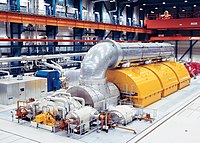
Photo from wikipedia
The typical textbook production theory for a single production unit, assuming substitution possibilities both ex ante and ex post between all factors of production, may not be so well suited… Click to show full abstract
The typical textbook production theory for a single production unit, assuming substitution possibilities both ex ante and ex post between all factors of production, may not be so well suited for understanding structural change within industries characterised by embodied technical change and a significant presence of capital equipment that represents sunk cost. In the literature an industry function is often based on just aggregating micro-level data to the industry level, or scaling up an average production function, using at times quite sophisticated econometric techniques to estimate a parametric production function. However, entry and exit of plants, and embodied technological change at the micro or plant level drive the dynamics. The requirement of plant level data has severely restricted the use of the approach. However, the paper shows that such production function concepts can be applied to coal-fired electricity generation aggregated to the Chinese province level and still get valuable structural information for policy analysis. Development in total variable factor productivity (TVFP) and bias of technical change are estimated and illuminated using figures for isoquant maps, capacity regions in input coefficient space and average- and marginal cost functions for the provinces in China.
Journal Title: Journal of Productivity Analysis
Year Published: 2019
Link to full text (if available)
Share on Social Media: Sign Up to like & get
recommendations!